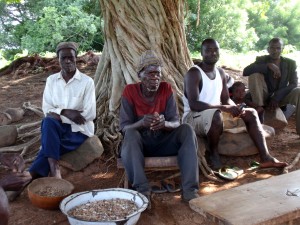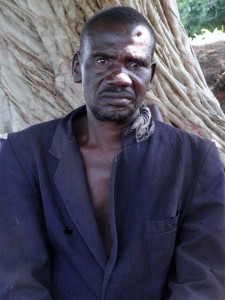This is the fifth of six posts I’ll be writing about the witch camps of Northern Ghana. You can find additional posts below.

The chief of the Yendi camp alongside accused wizards
Simon picks me up at 5 am. It is not yet dawn but the moment preceding it, and I can feel the impending energy of the sun pressing violently against the black clouds. The motorcycle weaves jaggedly across the dirt road and past the prison, the canteen and the hot yellow Western Union that signifies the end of town. The sun punches through the clouds, flooding the plain with a soft, purplish glow. Men, women and children pour out of the bush and onto the road, proceeding toward town with baskets of goods on their heads.
Simon and I are going to Yendi, to visit Ghana’s biggest witch camp, which holds over seven-hundred individuals. The village was the site of a small war–more aptly described as a chieftaincy crisis–in 2003. The violence was the result of a long-lasting dispute between the Abudu and Andani tribes, which vie for power in the area. The conflict began when a mob stormed the palace of the sitting Ya-Na ( the regional chief), beheaded him and then killed another forty townspeople. In the aftermath, only a few of the perpetrators were brought to justice, and hostile tensions still hover in the area.
The witch camp in Yendi is not actually located in the town, but about forty kilometers outside of it. Before we begin the trek, we visit with members of Songtaba. a non-governmental organization (NGO) that advocates for those accused of witchcraft. The organization is coordinated by Enoch Cudjo. A college graduate with a degree in social work, Cudjo is young and brash. He wears a bright purple dashiki and, like others, is a bit nervous about talking to the press. However, after a few minutes of feeling me out, he expounds on his efforts to help those in witch camps.
What Songtaba primarily focuses on is integrating community members and “accused witches†together so they can live cohesively. Cudjo says that one strategy that has been particularly successful was building a well for a village inside of a witch camp, thereby forcing the townspeople to interact with the accused witches when they fetched water. As I had with Simon, I ask Cudjo whether or not he believes in the existence of witchcraft and/or that the women in the camp are witches. The question jars him, and he refuses to answer outright. “It is not up to me to decide who’s a witch and who isn’t,†he says. “Instead, I prefer to work on enhancing integration.â€
Simon and I depart and head toward the camp. As we grow closer, the road becomes increasingly bad and the landscape bleak. We stop for gas on the side of the road, where three teenagers have a small station where they sell liters of fuel contained in beer bottles. Two of them have chunks of scarred flesh surrounding their navels from poorly cut umbilical cords.
Finally, we enter the camp. The architecture is identical to Gambaga and the small, crude huts stretch as far as the eye can see. Simon finds the chief sitting under a tree. He is dressed in old dirty clothes and appears nowhere near as regal as the Gambaranna. I purchase a libation (a bottle of aperteshie) for a dollar as a gift, and the chief gives it a blessing before slugging down a glass. There is only one plastic cup to drink from so we pass it and the bottle around. Finally, it is my turn. I grimace and slurp down three ounces of the clear, potent moonshine, trying to minimize my shiver to the delight of the chief and his advisors.
The language spoken is too rare for even Simon to understand well. However, there is one young boy who speaks English and he is summoned to assist me in interviews. The chief says something to one of his assistants and two minutes later a half-dozen beaten looking wizards appear. They are covered in dirt and mud and two of them are wearing ski caps with crescent points at the top; oddly, they do look a bit like wizards
Previously I have conducted all my interviews one on one, but I decide that because there are six wizards, and I am half -drunk on moonshine, I will host a roundtable. I direct the wizards to all sit on one bench and they do, patiently awaiting my inquiries like Catholic schoolboys preparing for the confessional. I ask them why they were accused of sorcery. Madjuri, who has been at the camp for three years, says that he killed some young boys.
“Did you really kill them or were you just accused of killing them?†I ask.
“I killed them,†he said.
“Well, why did you kill them?â€
As the question is being translated, every one–the chief, the translator, the wizards and Simon–begins to laugh. I realize it’s a ridiculous question, but I don’t know what else to ask.
“He doesn’t know,†the translator responds. “He says he just did.â€

An accused wizard in Yendi who had a nail hammered into his head
The wizard on the far end of the bench catches my eye. He’s dressed in an oddly fashioned royal blue jacket; it looks like something that a sea captain might wear. He has a massive scowling face, and I notice a strange indentation on his head. He tells me that he was accused of witchcraft by two young boys who said they saw a vision of him in their sleep. He was beaten by a number of different men, approximately a dozen times. Then, one day they held him down and pounded a nail into his skull. The nail is still in his head and he can no longer see out of his left eye.
I take a dozen pictures of him, like he’s an animal at a zoo, and then give Simon the wave that means I’m finished. I toss my Yendi translator a weird psychedelic eagle t-shirt that was sitting in my bag–his shirt has more holes than cloth–and bump fists with the remaining wizards before leaping on the back of the motorcycle. We have to push it to get back to Tamale before dark, and I bob up and down as the bike plunges through rut after rut.
Back in Tamale, I pay Simon $40 for five days of work. It comes out to $2 per hour and it’s more than he’s made in the last month. We sleep in a terrible hotel–everything else is booked because of a convention–and I wake up in the morning to a cockroach sidling up my leg. I head to the bus station and two hours later I am riding on the big, comfy STC passenger bus back to Accra. I’m done with Gambaga. I sleep the whole way; I need it badly. I haven’t slept right in a week.
Visit the Gambaga archive for the first three posts in this series or check out the photo gallery for more images from the witch camps of North Ghana.
Leave a Reply